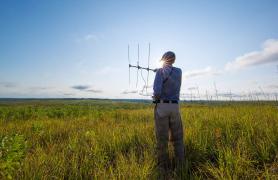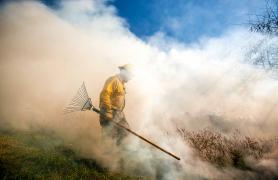Opossums get no respect. Granted, they’re not one of Missouri’s most beautiful creatures, and their habit of getting pancaked on highways might lead you to believe they’re dim-witted. Opossums are also notorious for digging through garbage or getting trapped in garages. But take a closer look at this curious creature, and you’ll find opossums are actually awesome.
Unlovely but Unique
Opossums’ beady black eyes, scruffy gray fur, and scaly pink tails make them look like overgrown rats to some, but they aren’t closely related to rats or any other rodent. Opossums are marsupials, just like kangaroos and koalas, and as America’s only marsupial, raise their babies in a pouch.
Opossums look scruffy because they don’t have thick, sleek coats like muskrats or mink. They aren’t able to put on much body fat, either, so they can’t go long without eating. This means winter can be rough for an opossum. They often lose toes and the tips of ears and tails to frostbite because those parts aren’t fur-covered. That said, this Southern native (its scientific name is Didelphis virginiana) has adapted to survive winter as far north as Canada.
Opossums won’t win any beauty contests, but they may take the prize for puzzling predators.
Furry Fakers
Opossums usually scurry to safety if danger threatens. But when something catches one by surprise, it bares its 50 teeth — the most of any Missouri mammal — and hisses, trying to bluff its way out of danger.
If a predator refuses to back off, however, the opossum collapses, appearing to be dead. Its breathing slows. It slobbers, and blows snot bubbles out its nose. Perhaps because opossums are famous for frothing and drooling when they’re “playing possum,” they’ve gotten a reputation for spreading rabies. In fact, opossums are resistant to rabies.
While it’s down and out, the opossum may also release a green fluid from its rear end that makes it smell worse than usual. Most predators lose their appetite at this point and leave the opossum alone.
Scientists call opossums’ habit of playing possum thanatosis, which means “death feigning.” But this response to danger isn’t playing or faking. Thanatosis is completely out of the animal’s control. It’s like overly stressed humans fainting. Threatened opossums can appear dead from four minutes to four hours. Once the threat leaves, the opossum’s ears begin to twitch, and it slowly wakes up.
No doubt this unusual adaptation helps opossums survive a few dangerous encounters in their otherwise short lives.
Live Fast, Die Young
Opossums don’t live long. Three-year-olds are rare, and 4-year-olds are almost unheard of. To make up for their short life spans, opossums don’t waste much time before they start breeding.
They find a mate about seven months after they’re born. After a 12-day pregnancy — the shortest of any North American mammal — a mother opossum gives birth to six to 20 babies.
Pouch Potatoes
Newborn opossums are about the size of kidney beans — 10 could fit in a teaspoon. The babies crawl from under their mom’s tail and make their way toward her pouch. Although the distance is short, the newborns are naked, blind, deaf, and have just two working legs. For them, the journey is a life-or-death race to find a space in the pouch, and some never cross the finish line.
Once inside, each baby clamps down on a nipple — mama opossums usually have 13 arranged in a “U” — and don’t let go for nearly two months. While they nurse on mom’s milk, the babies grow to chipmunk size. The pouch is fur-lined, and it stretches as the babies get bigger. Mom can open the pouch to cool her babies when they’re hot or clamp the pouch shut to keep her babies dry when it’s wet.
Having a pouch allows mama opossums to stay mobile. They don’t have to return to a den or nest every day — they carry their den with them.
Mother Minivans
When the babies are about 2 months old, they crawl out of the pouch. They’re still not able to survive on their own, so the mother opossum becomes a mobile home. The youngsters ride atop her back, clinging to fur as she forages for food.
While riding, young opossums learn survival skills, such as what to eat and how to avoid predators. When they are 100 days old, they become too heavy to hitch rides. But by this time, they’re able to fend for themselves.
Built for the High Life
An opossum’s tail is prehensile, meaning it can curl around things. Opossums can’t hang by their tails except for short periods, but they do wrap their tails around branches for balance.
Opossums have thumbs on their feet. These toes, called halluxes, are used to hold on to branches when climbing. Although they’re not as nimble as squirrels — opossums plod rather than scamper — they’re at home in the trees.
Drifty Gypsies
To an opossum, the world is an endless buffet. And when food is everywhere, it doesn’t matter where you sleep, as long as your bunk is dry, sheltered, and safe. Opossums wake shortly after sundown and wander about, shuffling and snuffling for food. When the sun begins to rise, they bed down wherever they wind up, often in a tree cavity, squirrel nest, hollow log, brush pile, abandoned groundhog den, or under a house. Opossums use their prehensile tails to gather leaves for a bed.
Nature’s Vacuum Cleaners
Opossums are omnivores with a capital “O.” These living, breathing vacuum cleaners eat anything they can find, including nuts, fruits, insects, worms, frogs, snakes, birds, eggs, rodents — even garbage and dead animals.
In an experiment with dogs, cats, and other intelligent animals, opossums scored second in their ability to remember where food is and then locate it. The only animal to outscore them was humans.
Garden Gurus and Snake Snarfers
Got an opossum in your garden? Lucky you. It will clean up fallen fruit and control pests while they’re at it. State Wildlife Veterinarian Dr. Sherri Russell emphasized the importance of opossums in gardens. “Eating rotten fruit keeps our environment tidy,” she said. When opossums eat rotting fruit, they reduce the risk of flies bringing diseases to gardens. They also eat pests that destroy gardens, such as snails, grubs, beetles, mice, rats, and gophers. “Opossums are an important part of the ecologic web,” Russell said.
If an opossum can’t find a nice garden to tend, it will make do with dirty, greasy burger wrappers and plastic snack cake packaging. Their bodies produce chemicals to protect them from the plastic and poison they consume. They’re even immune to snake venom, so rattlesnakes and copperheads occasionally find themselves on the menu.
MDC Wildlife Damage Biologist Jim Braithwait said he once received a phone call from a frantic family who said they had “a major snake problem.” Braithwait recommended they try attracting opossums to their yard. A few months later, the family called him back to say that their snake problem had diminished thanks to a friendly opossum.
Tick Terminators
Opossums have an impressive record when it comes to killing ticks. Although they attract about as many ticks as any other Missouri mammal, they’re also fastidious groomers. If they find a tick while grooming, they lick it off and swallow it. Every season, an opossum can kill around 5,000 ticks, possibly helping to control the spread of tickborne diseases where it lives — and where you live.
An Ounce of Prevention
Braithwait said that, while opossums can be a nuisance, it’s best just to leave them alone. However, if you want an opossum out of your yard, one of the simplest tricks is to secure all garbage and trash can lids and try to feed your pets indoors. If feeding pets indoors isn’t possible, Braithwait recommends making sure your pets eat all their food and bringing in what they can’t eat. “The best way to attract opossums is to leave your pet food out at night,” Braithwait said. Braithwait said another easy way to make your yard less appealing to opossums is to prune overgrown trees and shrubs, remove brush piles and debris, and clean fallen fruit from trees.
If an opossum takes residence under your house, barricade the entryway during the day since it’s sure to be sleeping. At dusk, if the barricade has been pushed out, the opossum is no longer inside. At this point, cover the entrance with chicken wire or a material that will block the entrance.
Braithwait said that if all else fails, use a live trap with any type of bait, and remove the opossum once you catch it.
Give Opossums a Brake
Next time you see an opossum waddling across the road at night, slow down and let it pass. After all, opossums do a lot of things for you, mostly while you’re asleep. They keep your yard and garden clean and free of pests, and they control ticks, which can transmit serious diseases to you and your pets. Opossums may not be pretty to look at, but they’re still pretty awesome.
Props for Opossums
More people are showing love for opossums on Facebook and other social media. It’s great to see a rise in respect for one of Missouri’s most unusual wild animals, but it’s also important to know the facts about opossums and their needs. If you love opossums, the best thing you can do for them is provide natural habitat. Plant a few persimmon trees, don’t rake your fall leaves, and make a little brush pile in an out-of-the-way place. While you may be tempted to adopt young survivors of road-killed mothers, it’s best to just move them into the woods, where they will remain natural members of their ecosystem. Some may survive, and others may die, but this is nature’s way for all wildlife
Opossum vs. possum
Most Missourians know the opossum by the shortened and informal “possum,” but that title rightfully belongs to a family of tree dwelling mammals native to Australia, New Zealand, and the surrounding islands known as Phalangeridae. This family includes the common brushtail possum (Trichosurus vulpecula) and the common ringtail possum (Pseudocheirus peregrinus).
While both animals are marsupials, and the possum’s name is derived from the opossum, the common possum species are more closely related to other Australian marsupials, such as the kangaroo, than they are to their American namesake.




Also In This Issue


And More...
This Issue's Staff
Associate Editor - Larry Archer
Staff Writer - Bonnie Chasteen
Staff Writer - Heather Feeler
Staff Writer - Kristie Hilgedick
Staff Writer - Joe Jerek
Creative Director - Stephanie Thurber
Art Director - Cliff White
Designer - Les Fortenberry
Designer - Marci Porter
Photographer - Noppadol Paothong
Photographer - David Stonner
Circulation - Laura Scheuler






















